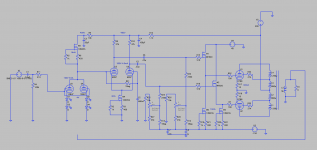Hi everyone,
I've looked a little bit and I didn't see anything similar to what I'm thinking of here. There is a traditional way of doing feedback for a long tailed pair, which I've linked below.
The Valve Wizard -Long Tail Pair
In my design, I'm using a CCS, which should theoretically balance the Long Tailed Pair fairly well, but I noticed in simulation that there was still a bit of imbalance. This seems to be similar in the amp I'm basing it off of and even looking at the FFT, the distortion may be inaudible, but the engineer in me doesn't like the imbalance. Using a CCS, I don't see a way to implement something similar to the above design, so please correct me if I missed something.
Has anyone implemented feedback on the LTP, like in the image attached below? Is there any reason that this would be a bad idea? In simulation, it appears to work and I have some gain to spare.
Thanks,
John
I've looked a little bit and I didn't see anything similar to what I'm thinking of here. There is a traditional way of doing feedback for a long tailed pair, which I've linked below.
The Valve Wizard -Long Tail Pair
In my design, I'm using a CCS, which should theoretically balance the Long Tailed Pair fairly well, but I noticed in simulation that there was still a bit of imbalance. This seems to be similar in the amp I'm basing it off of and even looking at the FFT, the distortion may be inaudible, but the engineer in me doesn't like the imbalance. Using a CCS, I don't see a way to implement something similar to the above design, so please correct me if I missed something.
Has anyone implemented feedback on the LTP, like in the image attached below? Is there any reason that this would be a bad idea? In simulation, it appears to work and I have some gain to spare.
Thanks,
John
Attachments
See this thread for others contribution. Started you part way down thread but feel free to go back to top.
With a CCS in the tail then no additional balancing feedback should be required.
Balance in CCS Long Tailed Pairs
Cheers,
Ian
With a CCS in the tail then no additional balancing feedback should be required.
Balance in CCS Long Tailed Pairs
Cheers,
Ian
The only balancing you need in a LTP is
1. Equal resistance plate load resistors
2. The next stage must present 2 equal loads
3. No grid current in the two control grids.
Your schematic was only partial, can not see the load presented by the next stage.
1. Equal resistance plate load resistors
2. The next stage must present 2 equal loads
3. No grid current in the two control grids.
Your schematic was only partial, can not see the load presented by the next stage.
Thanks, Ian that was definitely inciteful. The next stage is a Mosfet follower. As far as I can tell there's nothing that would lead to uneven loading, and the imbalance starts with the phase splitter. Maybe it's not a real issue, but only in simulation? The amplifier without the feedback is attached.
Attachments
Since it is being driven un-balanced, there will be a part-Volt unbalance of output due to non-infinite rp. You can see this in the deep-decimal display of a simulator. In real life with real tubes (especially the wide tolerance on OUTput tubes), it is hard to find.
1 meg resistor causes DC disbalance due to grid current.
Engineer in me, though, prefers better end results to better means, so I do not need perfect balance. 🙂
Engineer in me, though, prefers better end results to better means, so I do not need perfect balance. 🙂
- Home
- Amplifiers
- Tubes / Valves
- LNF for LTP

